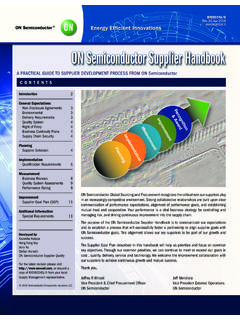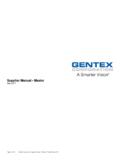Transcription of The Necessity of a Secure Supply Chain - C TPAT Certification
1 All Rights Reserved Trade Innovations, Inc. 2015 The Necessity of a Secure Supply Chain By Michael Laden In the United States, the tragic terrorist events of September 11, 2001 forever altered the way we process and think about global commerce. To be sure, the proliferation and scourge of smuggling has been a problem for many years, but in a post September 11th environment, the concerns related to a Secure Supply Chain grew exponentially. The smuggling of drugs, counterfeit goods, laundered money and/or human smuggling was now overshadowed by concerns about a nuke in a box . What if a terrorist organization could successfully penetrate and exploit an otherwise legitimate Supply Chain to introduce a nuclear weapon or a weapon of mass effect, such as anthrax?
2 In the weeks and months following the September 11th attacks, the legacy Customs Service (now called Customs and Border Protection or CBP) engaged the trade community in an effort to best determine how to Secure the Supply Chain . Initially CBP considered creating a mandatory security program that would apply to all shippers and all imports. But then, common sense and their consultation with the trade community altered that approach. To be successful, it was widely believed that such a program should be voluntary, not mandatory. The thinking was that a voluntary program would incentivize those companies who want to do the right thing and come forward willingly; in the end such a program would help CBP identify the known consignments from the unknown.
3 Conversely, if the program were made mandatory, all importers would be required to undertake the minimum Supply Chain security requirements; and the result would not help CBP differentiate from a trusted shipper versus a new or unknown shipper . Additionally the trade community was very vociferous in their beliefs that compliance with trade laws and Supply Chain security are mutually exclusive; that is each pillar should stand on its own merit. While highly compliant companies are more likely to also have a robust security program, the price of admission into a Supply Chain security should not be dependent on rigorous compliance audits or tax inquiries.
4 Such obstacles do little for incentivizing companies to participate in a program and blur the bright lines of distinction between compliance and security. After much thought and deliberation, CBP correctly adopted the right approach and today the Customs-Trade Partnership Against Terrorism (C- tpat ) program is a voluntary program devoid of measured compliance metrics. The C- tpat model was actually borrowed from the Business Anti-Smuggling Coalition (BASC), which may also be known in other countries as the Business Alliance for Secure Commerce. In the late 1990 s, as the drug smuggling problem into the became more pervasive and the cartels began to exploit otherwise legitimate Supply chains to move their illicit contraband, CBP developed BASC.
5 It was a voluntary security program designed to harden a Supply Chain to protect against unlawful contamination. After the attacks of September 11th, the BASC model was essentially retrofitted from an anti-drug smuggling program to be an anti-terrorism program designed to prevent and/or detect the unlawful introduction of any kind of contraband into the Supply Chain . So, the C- tpat program is a direct outgrowth of the terrorist attacks of September 11th, and is one of many layers of Supply Chain security adopted by CBP. Today, the C- tpat program has been widely recognized as one of the most successful private and public partnerships ever created. The program has more than 10,000 members and offers benefits to those companies in good standing.
6 Some of the other Supply Chain security layers that complement C- tpat are, the Container Security Initiative (CSI), radiation portal monitoring at foreign ports, the Importer Security Filing (ISF), and the advanced targeting of inbound containers. In June of 2005, the Brussels based World Customs Organization (WCO) adopted the SAFE Framework of Standards to Secure and Facilitate Global Trade1 (SAFE Framework). The WCO is made up of 180 1 World Customs Organization SAFE Framework of Standards to Secure and Facilitate Global Trade, June 2015 All Rights Reserved Trade Innovations, Inc. 2015 customs administrations around the world and its members are responsible for managing 98% of the world s global trade.
7 Once adopted, other customs administrations around the world began designing and implementing their versions of Supply Chain security regimes. Today, there are a number of different Supply Chain security programs that have been fully implemented by some of the WCO Members; others are still being designed and deployed. Once implemented, the (along with other WCO Members having security programs in place) begin to negotiate Mutual Recognition Agreements2 (MRA s); whereby each customs administration validates the security requirements and practices of the other. To date, the has signed a total of ten (10) MRA s: New Zealand - June 2007 New Zealand Customs Service s Secure Export Scheme Program Canada - June 2008 Canada Border Services Agency s Partners in Protection Program.
8 Jordan - June 2008 Jordan Customs Department s Golden List Program. Japan - June 2009 Japan Customs and Tariff Bureau s Authorized Economic Operator Program. Korea - June 2010 Korean Customs Service s Authorized Economic Operator Program. European Union - May 2012 European Union s Authorized Economic Operator Program. Taiwan - November 2012 Directorate General of Customs, Taiwan Ministry of Finance s Authorized Economic Operator Program.* Israel June 2014 - Israel Tax Authority s Authorized Economic Operator Program. Mexico - October 2014 - Mexico Tax Administration Service's New Scheme of Certified Companies (NEEC) Program Singapore December 2014 Singapore Customs Secure Trade Partnership (STP) Program The WCO, to which Peru is a signatory, offers its members a number of tools and guidance to assist in the creation of a meaningful Supply Chain security program.
9 Under the guise of the WCO SAFE Framework, Peru created an AEO program in 2012, the program however has been met with timid results and only a small number of Peruvian companies who may qualify have joined the program. This might be because applying for Peru AEO status is also accompanied by a strenuous tax assessment; in my opinion it is similar to being punished for trying to do the right thing. Peruvian customs authorities would be well-advised to reconsider this approach. I realize that the term or word partnership is foreign to many customs authorities, but I am a fervent believer that a true partnership between the public and private sector must be the cornerstone of any meaningful Supply Chain security program.
10 Research data published by Transparency International and the Freightwatch International Threat Assessment characterize Peru as having many opportunities for improvement in the area of corruption and security. As such, Peru is viewed by the rest of the world as a medium-high to high risk country as it is related to Supply Chain security. In order to maintain its competitive advantage in the global trade markets much needs to be done to improve the integrity and security around Peruvian exports. Carrying a high risk rating means that most imports to the from Peru will be fully scrutinized; often resulting in substantial delays and extra costs for the importer.



